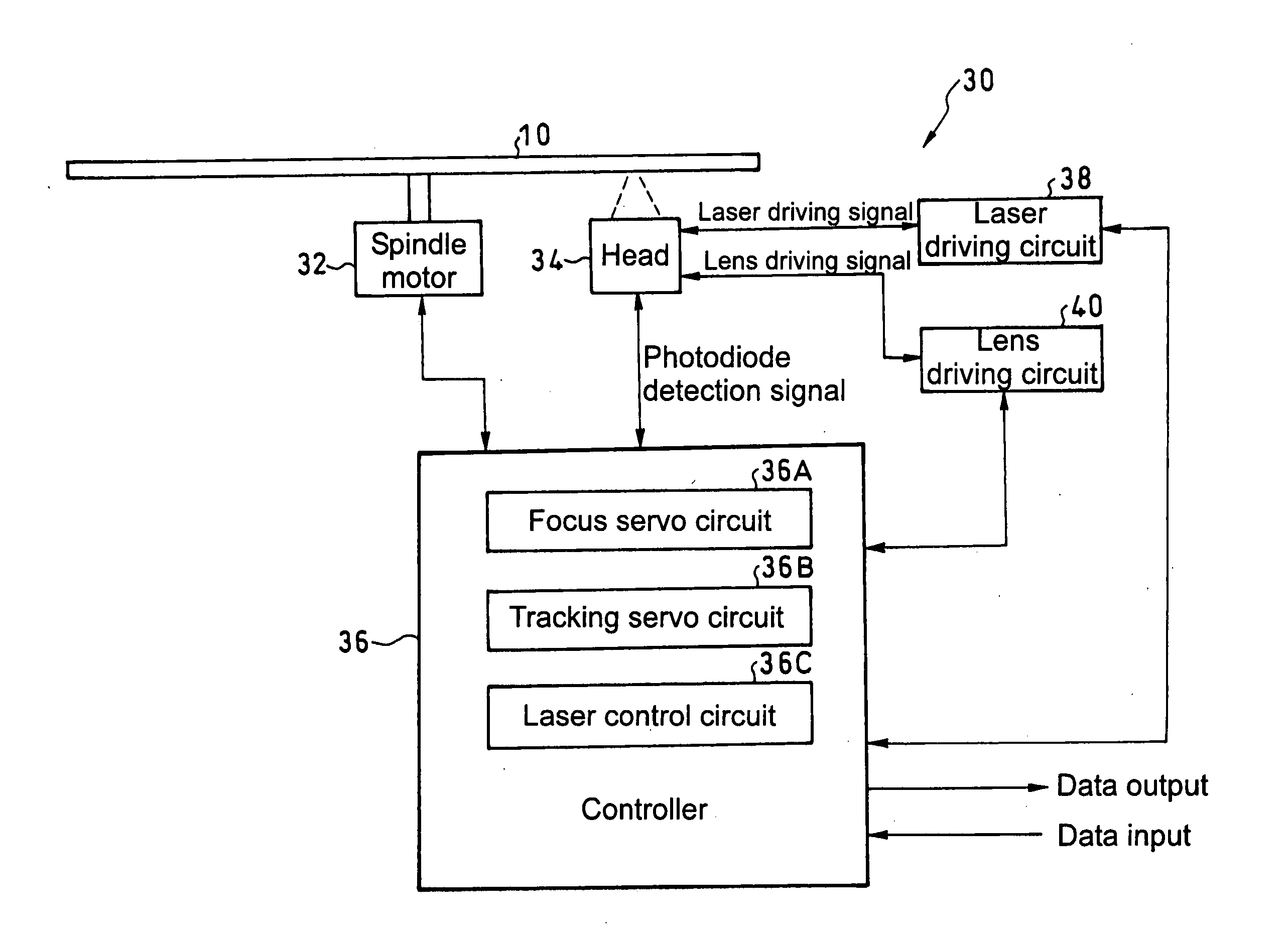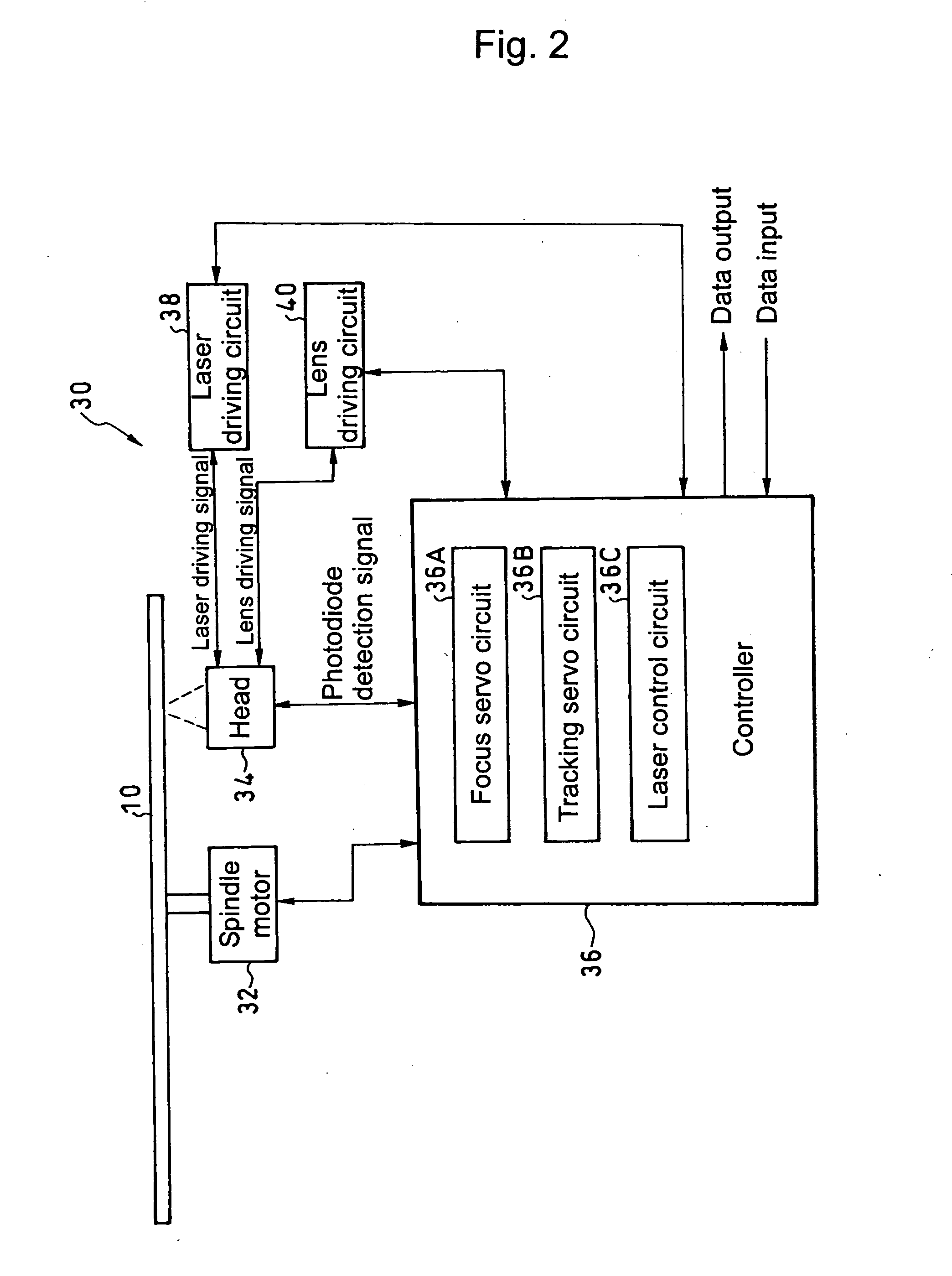Method of recording information on optical recording medium, and information recording and reproducing apparatus
a technology of optical recording medium and information recording apparatus, which is applied in the field of recording information on optical recording medium, information recording and reproducing apparatus, can solve the problems of thermal interference between the adjacent recording marks or thermal interference between tracks, slow cooling structure of the light incident side recording layer, and the problem of thermal interference between the recording marks or the cross-erase between tracks, etc., to prevent thermal interference and prevent thermal interference
- Summary
- Abstract
- Description
- Claims
- Application Information
AI Technical Summary
Benefits of technology
Problems solved by technology
Method used
Image
Examples
first exemplary embodiment
[0031] Hereinafter, a first exemplary embodiment of the present invention will be described in detail with reference to FIGS. 1 and 2.
[0032] An optical recording medium 10, on which information is to be recorded by a method according to the first exemplary embodiment, includes: a substrate 12; a first recording layer (an L0 layer) 14; a transparent intermediate layer 16; a second recording layer (hereinafter, simply referred to as a recording layer) 18 (an L1 layer); and a light transmitting layer 20. The above-mentioned layers 14 to 20 are deposited in this order on the substrate 12.
[0033] As is illustrated in FIG. 1 in an enlarged manner, the recording layer 18 includes: an underlayer 18A; a metal heat-sink layer 18B; a second protective layer 18C; a phase-change recording layer 18D; and a first protective layer 18E, deposited in this order from the side of the transparent intermediate layer 16.
[0034] The metal heat-sink layer 18B serves for heat dissipation and an optical inte...
second exemplary embodiment
[0054] A second exemplary embodiment of the present invention will now be described.
[0055] A recording strategy according to the second exemplary embodiment is set as follows in addition to the recording strategy according to the first exemplary embodiment described above. The single write pulse width Tw is set to satisfy: 0.2
[0056] If the single write pulse width Tw is too long, heat is normally accumulated in a track width direction of the optical recording medium when a recording mark is formed, whereby the cross-erase is likely to occur. However, if the single write pulse width Tw is set to satisfy: 0.2<Tw / T<0.6 as in this second exemplary embodiment, the occurrence of cross-erase can be avoided even in the recording layer having a slow cooling structure. On the other hand, if the single write pulse width Tw is shorter than 0.2T, it becomes diffic...
example 1
[0058] In Example 1 of the present invention, the double-layered optical recording medium shown in FIG. 1 was fabricated as follows so as to evaluate recording and reproduction characteristics of the second recording layer.
[0059] The optical recording medium included: the substrate having a thickness of 1.1 mm; the transparent intermediate layer having a thickness of 25 μm; and the light-transmitting layer having a thickness of 75 μm.
[0060] The phase-change recording layer included in the second recording layer was made of an Sb eutectic alloy and had a thickness of 6 nm. The metal heat-sink layer was made of an Ag alloy and had a thickness of 15 nm. The first protective layer, the second protective layer, and the underlayer layer were formed as laminate layers made of dielectric materials, AlN, ZnS.SiO2, and ZrO2, respectively. The thicknesses of these layers were 55 nm, 5 nm, and 20 nm, respectively.
[0061] After the phase-change recording layer was converted to a crystalline st...
PUM
| Property | Measurement | Unit |
|---|---|---|
| light transmittance | aaaaa | aaaaa |
| light transmittance | aaaaa | aaaaa |
| thickness | aaaaa | aaaaa |
Abstract
Description
Claims
Application Information
 Login to View More
Login to View More - R&D
- Intellectual Property
- Life Sciences
- Materials
- Tech Scout
- Unparalleled Data Quality
- Higher Quality Content
- 60% Fewer Hallucinations
Browse by: Latest US Patents, China's latest patents, Technical Efficacy Thesaurus, Application Domain, Technology Topic, Popular Technical Reports.
© 2025 PatSnap. All rights reserved.Legal|Privacy policy|Modern Slavery Act Transparency Statement|Sitemap|About US| Contact US: help@patsnap.com



